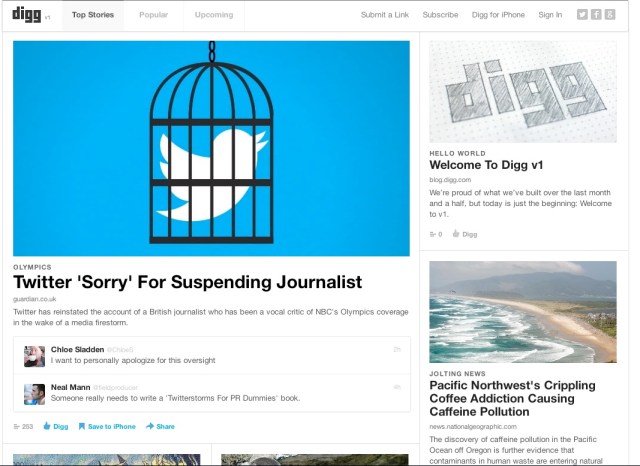By Kristi Hines at KISSmetrics:
While Digg, formerly one of the top social voting sites on the Internet,
lost a lot of its luster since their major update last year to version
four, they still receive at least
2.5 million visitors per month in the US alone and have an Alexa rating of 167, PageRank of 8, and Domain Authority of 100.
Digg is also a little bit more marketing friendly than their main competition
Reddit. The following guide will help you learn to use Digg for sharing your awesome content with a larger audience.
How Digg Works
Members of the Digg community can submit and share content to the
Digg network under the main categories of Business, Entertainment,
Gaming, Lifestyle, Offbeat, Politics, Science, Sports, Technology, and
World News. These broad categories allow for almost any area of content
to be submitted.
When content is voted upon by other members of the Digg community
(also known as getting diggs or being dugg), it gets the chance to be
discovered not only by your own followers, but also the community at
large by making it to the Holy Grail – the Digg homepage (or when you’re
logged in, the Top News section). While the exact formula to what gets
on the homepage is a mystery, the general theory is that a submission
which receives a high number of votes within a short amount of time will
likely make it to the top of the list.
Setting Up Your Digg Profile
Once you create an account on Digg, you can add some information about yourself under your profile settings including:
- Full Name – If you want people to be able to find your Digg profile
amongst search results for your name, you’ll want to put your real name
here.
- About Yourself – Put in some details about who you are and your
interests so people sharing the same interests will be more likely to
follow you.
- Links – You can add up to five links to any website you choose on
your profile. The exception is links to your Twitter or Facebook –
these won’t show up. Google+ will though. Although the links are
nofollow (meaning they get little SEO value), they are handy to have up
in case someone wants to know more about you.
The other thing you can customize under your profile settings is your
Viewing Digg options. You can set your default view to My News (the
latest submissions made by people you are following) or Top News (the
top submissions made by the entire Digg community), how to open external
links (within a new window or the same window), how to order comments,
and other details.
Getting Followers
If you want your submissions to get views and diggs, the best place
to start is by having a strong Digg following. Getting followers on
Digg is a bit more tricky than getting followers on Twitter. My best
tips on the matter are as follows.
- Digg and comment on submissions in your area of interest. The more active you are, the more your profile will be seen by others and followed by people with similar interests.
- Link to your Digg profile everywhere. This includes your
email signature, forum signature, website, blog, and social networks
that allow you to have links to your other social profiles such as
Google+ and Facebook. Give your Digg profile a tweet every now and
again too so you can get new followers off of your Twitter connections.
- Follow people in hopes that they follow you back. If you
want to find new people to follow on Digg, including the top users based
on most promotions, rising stars, and top commenters, you will want to
visit the Find People page. You can find people based on who you are currently connected with on Twitter, Google, and Facebook too.
Getting Diggs
Now, the part you’re probably the most interested in – how to get
diggs for your submissions. From my experience, your best bets are the
following:
- Add the Digg Button to your content.
Digg offers a few styles to choose from – you can add the JavaScript
code directly onto pages you want dugg or, for self-hosted WordPress and
other CMS driven sites, you can add the JavaScript code into your
theme’s template.
- Share your submission on Twitter. If you’re not sure people
will get the hint by just directing them to your piece of content with
the integrated Digg Button, your next option is to send them directly to
the submission itself on Digg. To get a link to your submission, just
click on the comments for the it and share the direct URL which usually
looks like digg.com/news/category/your_submissions_title. I wouldn’t ask often, but it never hurts to throw out the occasional Digg request to your followers on Twitter.
- Reach out to people directly via Instant Messenger and email.
Some of the most successful pieces of content (besides the ones that
naturally get diggs) are the ones marketed by people with a network.
Know who your connections are that use Digg and send them a friendly
request to give your submission a vote if they like it.
-
New: The Digg Newsroom
Your Digg Experience
What has your experience with Digg been since the last revamp of the system? Please share your tips and tricks in the comments!
About the Author: Kristi Hines is a freelance writer, blogger, and social media enthusiast. Her blog Kikolani focuses on blog marketing, including social networking strategies and blogging tips.




















